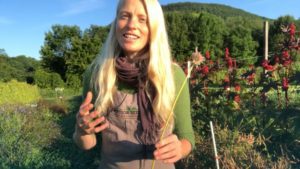We love to share what we love... and we love garlic and shallots! You'll find gorgeous seed garlic & shallots listed here every late Summer/early Fall. And don't forget the fertility... our Organic Garlic and Shallot Fertilizer has specially blended diverse amendments to feed both our soil and our alliums, and in turn, us!
Transcript: This morning, I would love to share with you a little bit about bulbils on garlic. So, what is a bulbil on a piece of garlic? A bulbil is a little propagule, a little bit of clonal vegetative propagation material. Essentially, it’s a seed of garlic. But here’s the thing, it’s not an actual seed. A true seed has sexual reproduction where there’s a male gamete, a female gamete. They’re unzipping — that DNA unzips itself and then resets itself with fresh genetic material from another parent. And then that seed has something of recombination of genetics that has never existed before on the planet.
So, a lot of crops, like potatoes, for example, and garlic — they’re vegetative, they’re clonal, there is no sexual reproduction. It’s asexual, which means that they’re reproductive bitlits, but there hasn’t been any recombination of genetics. And so you’ll find these marvelous little bulbils only on hardneck garlic. In fact, here’s the hardneck itself. it emanates from the top of the bulb, and we know them as scapes in July, when they come up, pardon me in June when they emerge. And by July, they’ve turned into these curly really beautiful things. And as they mature their bulbils that curl tends to straighten here you have the this scape that once was quite curly, now is totally straight up in the air full of bulbils.
So sometimes they’re very small. This, in fact, is a very small one, you can see there is a single one, you can’t even see it from my fingers. It’s about the size of maybe an apple seed. So super small. And that’s garlic. It’s this little little bit of garlic. But it is also granted now it’s a little on the soft side. But yeah, the wrapper on it, it has a wrapper on it. It’s not just this little bit of unwrapped garlic, it’s like there is there’s a solid layer of skin around the edge. Just like garlic bulb has a wrapper has wrappers around it. They’re kind of papery — so too do the bulbils. But sometimes these bulbils, often they’re small like this one, but sometimes they’re the size of a blueberry, and you’re like, “Oh gosh, you look beautiful, can I plant them?” And the answer is really resist it.
But unless you’re going to plant them close together, and here’s why. Because each of these little tiny bulbils will grow into not a bulb of garlic, but a single clove of garlic which once you have a clove of garlic, you can plant that that turns into a bulb of garlic. So yes, you *can* plant them in that context. But honestly, if you want to be harvesting bulbs of garlic, don’t bother with the bulbils. Just start with a clove to begin with, and the biggest, most beautiful bulb that you can begin with.
So what can you do with these bulbils, friends? Here’s what you can do: I like to just– any of these small ones just go on the compost. Admittedly, we harvest all our scapes and make scape pickles, lacto fermented scape pickles out of them, so we eat them. So they don’t even get a chance to make these scapes and their subsequent bulbils. But if you do have some, and they’re bloody huge and beautiful, here’s the thing. Plant them close together this fall in some kind of even a container, raised bed in a garden space and literally have them like an inch, a half inch, have them really close together. And then they’re going to overwinter.
In the spring, they will emerge as the snows melt and then you’ll have this carpet of garlic chives, essentially. So you’re going to be eating them. Really before June, before they’re starting to even pretend to become anything like a clove of garlic. You’re gonna leave the bulb in that ground, you’re gonna leave that clove, that garlic propagule itself in the ground and you’re just going to be eating the greens, that green as in garlic chives. And that way when you plant them that close together, you’ll have this lovely sea of garlic that is this delightful green.
I love them and frittatas on eggs chopped into salads, on soups all anyway that you’d use chives in your life, use these bulbils but again, don’t give them much space because then you’ll just have all this room for weeds to grow. And yet I can’t recommend highly enough as tempting as it is to grow garlic from your little lovely propagules. Even if they’re massive the size of blueberries. You’re much better off treating garlic by planting big beautiful cloves from big abundant bulbs and then you will harvest incredible bulbs.
But you don’t want to waste the bulbils–I totally get it. Just grow yourself an ocean and then you’ll have cutting green, garlic chives all spring, and I think you’ll be pretty pleased.


